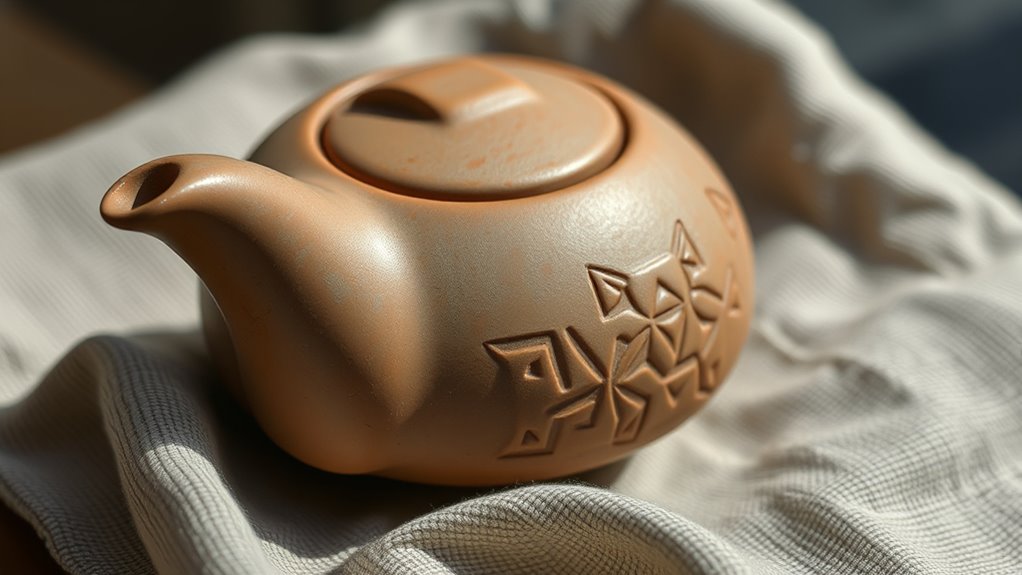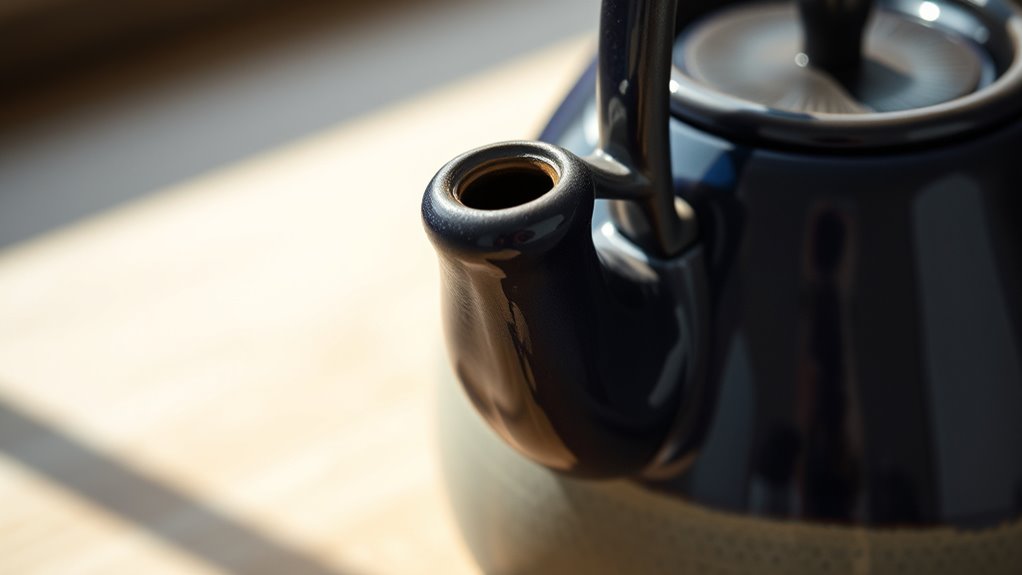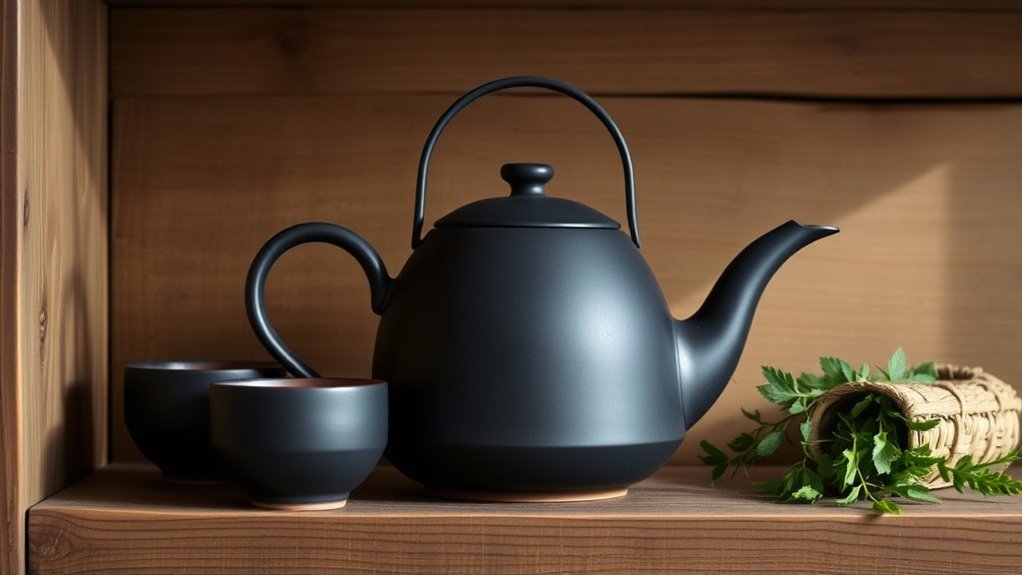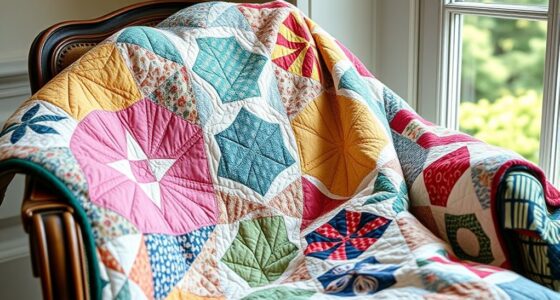Functional art blends beauty and practicality, transforming everyday objects into expressive works that serve a purpose. From historic handcrafted tools to modern minimalist designs, it emphasizes craftsmanship, innovative materials, and thoughtful aesthetics. These creations enhance both personal and public spaces—making them visually appealing while highly useful. If you’re curious about how design can elevate your environment with elegance and function, there’s much more to explore below.
Key Takeaways
- Functional art seamlessly combines aesthetic appeal with practical utility in objects and environments.
- Traditional craftsmanship techniques are enhanced by modern technologies to create innovative, beautiful, and useful designs.
- Iconic examples like the Eiffel Tower and minimalist devices illustrate the integration of beauty and structural or technological function.
- Artistic elements such as decorative storage, lighting, and public art elevate everyday spaces into visually engaging experiences.
- Incorporating cultural symbols into functional art revitalizes heritage and fosters meaningful cultural dialogue.
The History and Evolution of Functional Art

Throughout history, functional art has evolved from simple utilitarian objects to intricate works that blend beauty with practicality. In medieval craftsmanship, artisans transformed basic tools and everyday items into decorative pieces, elevating their aesthetic appeal without sacrificing utility. Ancient utilitarian objects, like pottery or metalwork, served daily needs but also reflected cultural values and artistic skill. Over time, these objects became more than just functional—they showcased craftsmanship and artistic expression. As societies progressed, artisans experimented with new materials and techniques, making everyday objects more visually appealing while still serving their purpose. This evolution highlights how functional art bridges the gap between practicality and beauty, laying the foundation for modern design where utility and aesthetics coexist seamlessly. Additionally, the integration of holistic wellness principles into functional art reflects a broader societal emphasis on health and emotional well-being.
Iconic Examples of Practical Beauty in Design

You can’t ignore how the Eiffel Tower combines structural innovation with aesthetic grace, making it a symbol of practical beauty. Apple’s minimalist devices showcase simplicity that’s both elegant and functional, transforming everyday tools into art. Meanwhile, bentwood chairs exemplify craftsmanship, turning traditional techniques into timeless, practical design. In home theater setups, choosing projectors with high contrast ratios ensures vibrant images and rich details, demonstrating how technical features can enhance both function and form.
Eiffel Tower’s Structural Elegance
The Eiffel Tower exemplifies how structural engineering can achieve both functionality and aesthetic appeal. Its Eiffel Tower’s structural elegance is a marvel of design, combining strength with grace. Standing tall in the Parisian urban skyline, it captures attention through its intricate iron latticework, which balances weight and stability seamlessly. Its open framework not only reduces material use but also creates a visually light presence amid the cityscape. Beyond its engineering feats, the tower has become a powerful cultural symbolism of innovation and progress. You can see how its practical purpose as a radio broadcast tower coexists with its iconic form, inspiring admiration worldwide. The Eiffel Tower’s design proves that beauty in structure can serve a purpose while elevating the environment around it. Decoding slang helps us appreciate how language can also blend function and style in communication.
Apple’s Minimalist Devices
Apple’s minimalist devices exemplify how practical beauty can redefine everyday technology. Their sleek designs showcase apple innovation, blending form and function seamlessly. These devices aren’t just visually appealing—they’re built for efficiency and ease of use. For example, the support hours for Apple products and services ensure users can get assistance when needed, reflecting a commitment to user experience. Consider these iconic examples:
- The iPhone’s clean, single-sheet design simplifies interaction.
- The MacBook’s thin, unibody aluminum shell exemplifies minimalist technology.
- The Apple Watch’s streamlined interface merges style with health tracking.
- The iPad’s elegant form enhances portability without sacrificing power.
Bentwood Chairs’ Craftsmanship
Bentwood chairs exemplify how craftsmanship can merge practicality with timeless beauty. Their appeal lies in the skillful use of handcrafted techniques and careful material selection. The process involves steaming and bending wood into elegant curves, showcasing the artistry behind their design. Each chair reflects meticulous attention to detail, balancing strength with grace. The choice of wood, typically beech or oak, ensures durability while maintaining a lightweight form. The craftsmanship transforms simple materials into functional art, where every curve and joint serves a purpose. Additionally, understanding toilet flushing mechanisms can inspire designers to incorporate sustainable features into everyday objects. Below is a glimpse into key elements of their craftsmanship:
| Technique | Material Selection | Functionality |
|---|---|---|
| Steaming bends | Beech or Oak | Lightweight, durable, elegant design |
| Hand shaping | High-quality wood | Precise, sturdy structure |
| Joinery methods | Natural wood | Long-lasting, seamless appearance |
| Finishing touches | Smooth polish | Enhances beauty, protects surface |
| Artistic curves | Carefully selected | Combines practicality with aesthetic appeal |
Materials and Techniques Behind Functional Artworks

Understanding the materials and techniques behind functional artworks reveals how artists seamlessly blend practicality with creativity. You’ll find that mastering techniques like applying ceramic glazes enhances both durability and visual appeal. Metal forging allows artisans to shape sturdy, elegant structures for everyday objects. To deepen your appreciation, consider these key methods:
Mastering ceramic glazes and metal forging elevates both the beauty and durability of functional artworks.
- Using ceramic glazes to create colorful, protective surfaces on pottery and tiles.
- Employing metal forging to craft strong frames and intricate details in furniture or tools.
- Combining different materials for innovative, multi-functional designs.
- Utilizing precise craftsmanship to balance form and function seamlessly.
The Role of Aesthetics in Everyday Objects

When artists combine form and function through expert craftsmanship, they elevate everyday objects beyond mere utility to expressions of beauty. Aesthetic simplicity plays a crucial role, making objects not only useful but visually pleasing. You notice how a well-designed mug fits comfortably in your hand, its clean lines and balanced proportions enhancing your experience. The harmony between form and function ensures that beauty doesn’t compromise usability; instead, it amplifies it. In everyday objects, this balance creates an effortless elegance that improves your daily routines. When simplicity is prioritized, clutter is minimized, and the object’s purpose remains clear. You begin to see how thoughtful design transforms common items into small works of art—functional, beautiful, and meaningful. Additionally, understanding the value of craftsmanship helps appreciate the skill involved in creating objects that are both durable and aesthetically appealing.
How Functional Art Enhances Residential Spaces

When you incorporate functional art into your home, you create spaces that are both beautiful and practical. Artful storage solutions keep clutter at bay, while artistic lighting adds warmth and character. Unique decorative elements transform everyday areas into expressions of your personal style. Integrating interior design tips can further enhance how functional art balances form and function in your space.
Integrating Artful Storage
Integrating artful storage transforms everyday functionality into a statement of style within your home. By choosing decorative storage solutions and artistic shelving, you turn clutter into a design feature. Here are four ways to do it:
- Use decorative storage baskets that add texture and color to your space.
- Install artistic shelving that doubles as wall art, displaying books or decor.
- Incorporate hidden compartments disguised as art pieces for a sleek look.
- Mix different materials and shapes for a dynamic, personalized storage system.
These options not only keep your space organized but also showcase your taste. Artful storage elevates practicality, making storage a beautiful, integral part of your home’s aesthetic.
Artistic Lighting Solutions
Artistic lighting solutions transform everyday illumination into striking design statements that enhance your home’s ambiance. By using innovative lighting technology, you can create tailored atmospheres that reflect your style and mood. Color psychology plays a crucial role; warm tones foster comfort, while cool hues promote calmness. Thoughtfully designed fixtures serve a dual purpose—lighting your space while acting as artistic focal points. Adjustable lighting options allow you to switch from functional brightness to mood-setting illumination effortlessly. Smart lighting systems enable precise control, enhancing convenience and ambiance with a simple tap or voice command. These solutions turn practical lighting into an integral part of your home’s aesthetic, proving that even illumination can be a form of functional art that elevates your living environment.
Unique Decorative Elements
Have you ever noticed how a single decorative element can dramatically transform a room? Unique decorative elements, like ornamental motifs and intricate decorative patterns, give your space personality and charm. They serve both aesthetic and functional purposes, making your home more inviting. Here are four ways they enhance your space:
- Create Visual Interest: Bold ornamental motifs draw the eye and add character.
- Add Personal Style: Custom decorative patterns reflect your taste and personality.
- Improve Flow: Functional art elements, like decorative screens, define spaces seamlessly.
- Enhance Atmosphere: Artistic accents evoke emotion and set the mood. Incorporating sound design techniques can also subtly influence the ambiance of your space, creating a more immersive environment.
These elements combine beauty and purpose, elevating your home’s style while serving practical needs.
Functional Art in Public and Architectural Settings

When art becomes part of the public or architectural environment, it transforms functional spaces into engaging, memorable places. Urban murals add vibrant visuals to city walls, turning blank surfaces into storytelling canvases that inspire and unite communities. Garden sculptures bring artistry outdoors, blending beauty with practicality by marking pathways or defining spaces. These artworks serve more than decoration—they enhance the environment’s identity and usability. Public art invites interaction and reflection, making everyday spaces feel special. Architectural elements like decorative facades or integrated sculptures turn buildings into landmarks, showcasing creativity while fulfilling structural purposes. By combining form and function, these artworks elevate the visual landscape, making public and architectural settings both functional and inspiring. Additionally, incorporating artistic design principles can further improve how these pieces serve their practical roles while enriching their aesthetic appeal.
The Intersection of Craftsmanship and Innovation

The blending of craftsmanship and innovation creates a dynamic space where traditional techniques meet cutting-edge ideas, pushing the boundaries of functional art. This fusion allows you to explore how artisans adapt cultural symbolism into modern designs while resisting mass production’s sameness. Here are four ways this intersection influences you:
- Revitalizing Cultural Symbols – artisans incorporate meaningful motifs into innovative forms.
- Balancing Uniqueness and Scalability – craftsmanship guarantees originality, even as mass production attempts to replicate.
- Pushing Technological Boundaries – new tools enhance traditional skills, creating fresh, functional pieces.
- Creating Cultural Dialogue – innovative designs reflect evolving identities while respecting heritage.
Contemporary Trends in Practical Artistic Creations

Contemporary trends in practical artistic creations are shaping how you experience everyday objects. You’re likely noticing a shift toward biophilic design, which integrates natural elements into functional art to foster well-being and connection with nature. Artists and designers now prioritize sustainable materials, ensuring their creations are eco-friendly and reduce environmental impact. This blend of aesthetics and purpose emphasizes beauty that serves a purpose, making your daily environment more inspiring and mindful. You may see furniture, decor, or accessories crafted from reclaimed wood, recycled metals, or biodegradable composites, all reflecting a commitment to sustainability. These trends not only enhance functionality but also promote ecological consciousness, allowing you to enjoy art that elevates your space while respecting the planet.
Collecting and Appreciating Functional Art

Have you ever considered how collecting functional art can deepen your appreciation for everyday objects? When you gather pieces rooted in cultural symbolism, you connect with stories and traditions that give these objects emotional resonance. To truly appreciate functional art:
- Explore its historical and cultural significance to understand its deeper meaning.
- Notice how design elements enhance both beauty and utility, blending form with function.
- Observe how each piece evokes emotional resonance, making it more than just an object.
- Curate a collection that reflects your personal connection to these stories and symbols.
Frequently Asked Questions
How Does Functional Art Influence Modern Interior Design Trends?
Functional art influences modern interior design by emphasizing space utilization and aesthetic balance. You’ll notice designs that blend practicality with beauty, making every piece serve a purpose while enhancing the overall look. This trend encourages you to choose furniture and decor that are both stylish and functional, creating a harmonious environment. By integrating functional art, you optimize your space while maintaining a visually appealing and balanced interior.
What Are the Ethical Considerations in Creating Functional Art?
When creating functional art, you should consider ethical issues like respecting cultural significance and guaranteeing responsible material sourcing. Avoid cultural appropriation by understanding and honoring the traditions behind the design. Use sustainable, ethically sourced materials to minimize environmental impact. By prioritizing these aspects, you demonstrate respect for cultures and promote responsible craftsmanship, helping to ensure your art benefits both the community and the environment while maintaining aesthetic and functional value.
Can Functional Art Be Personalized for Individual Needs?
Yes, you can personalize functional art to suit your individual needs. Many artists offer customization options, allowing you to choose colors, materials, and even incorporate user-specific designs. This way, your functional art not only serves a purpose but also reflects your unique style and requirements. By working with creators, you guarantee that the piece aligns perfectly with your preferences, making it both practical and truly personal.
How Do Functional Art Pieces Impact Environmental Sustainability?
Functional art pieces positively impact environmental sustainability by using sustainable materials and eco-friendly processes. You can choose artworks made from recycled or biodegradable materials, reducing waste and conserving resources. By supporting artists who prioritize eco-conscious methods, you help lower carbon footprints and promote responsible production. Your choices encourage a shift toward sustainable practices in the art world, making a meaningful difference for the environment while enjoying beautiful, purposeful pieces.
What Skills Are Essential for Artists Working in Functional Art?
You need to master craftsmanship techniques and make thoughtful material selections to excel in functional art. Evidence suggests that combining technical skills with an understanding of materials creates durable, beautiful pieces. You should also develop an eye for design and sustainability, ensuring your work serves both aesthetic and practical purposes. By honing these skills, you’ll craft functional art that resonates emotionally while maintaining structural integrity and environmental consciousness.
Conclusion
So, next time you marvel at a beautifully crafted chair or a stunning lamp, remember—it’s not just eye candy. It’s functional art, proving that beauty and practicality can actually coexist without a boring compromise. Who knew that everyday objects could be so stylishly clever? So go ahead, indulge in these masterpieces—your home (and your Instagram feed) will thank you. After all, why settle for boring when art can serve a purpose?








